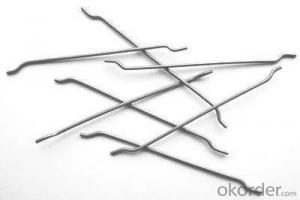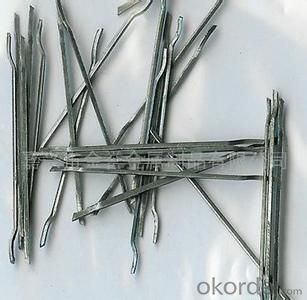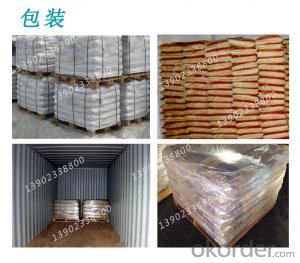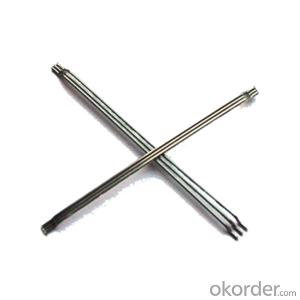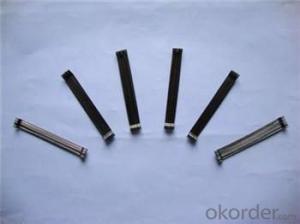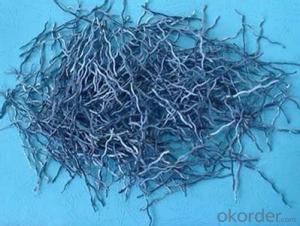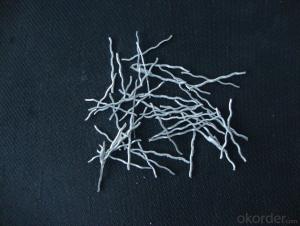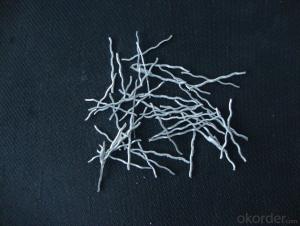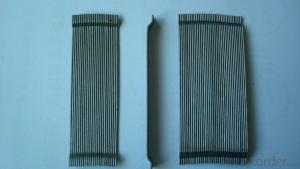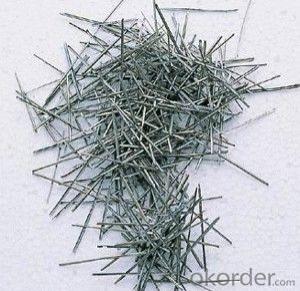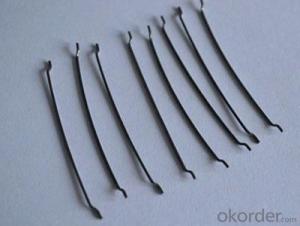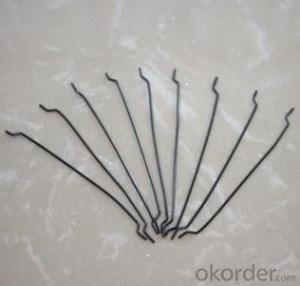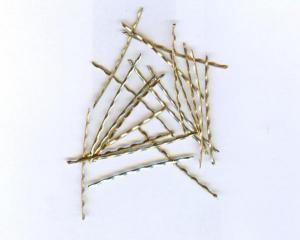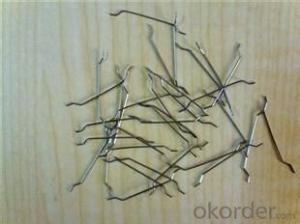Melt Extract Stainless Steel Fiber Low Carbon End Hook Concrete Steel Fiber
- Loading Port:
- Tianjin
- Payment Terms:
- TT OR LC
- Min Order Qty:
- 1000 kg
- Supply Capability:
- 250000 kg/month
OKorder Service Pledge
OKorder Financial Service
You Might Also Like
Quick Details
Place of Origin: China (Mainland)
- Material: Steel
material: steel wire
application: for concrete reinforcement
appearance: clean and bright
shape: steel fiber
Product features
concrete steel fiber is specifically to enhance concrete in its hardened state ,the uniform distribution of steel fiber throughout the concrete greatly improve concrete bonding and tensile strength ,additionally it provides exceptional load stability and durability ,as reliable and efficient concrete reinforcement material
it is widely ued in buildings ,bridges ,thin roo engineering ,highway etc.
Specifications
length :20-60mm
diameter :0.5MM-1.2MM
tensile strengh:>1100Mpa
| diameter | length | tensile strength | |
| 0.5mm | 35mm | 1100Mpa | |
| 0.75 | 60mm | 1100Mpa | |
| 0.9 | 60m | 1100Mpa |
others can do according to your requirement
Picture
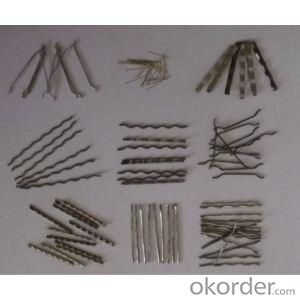
steel fiber for concrete
FAQ
we can produce any type steel fiber and of course we can make production according to your requirement
we have specilize in this field for almost 10 years ,with good quality and competitive price
- Q: Does the addition of melt extract stainless steel fiber affect the workability of concrete?
- Yes, the addition of melt extract stainless steel fiber can affect the workability of concrete. The inclusion of stainless steel fibers in concrete can increase its viscosity and reduce its flowability. This means that the concrete becomes less fluid and more difficult to work with, especially during the pouring and placement phases. The stainless steel fibers act as reinforcement within the concrete matrix, providing additional tensile strength and improving its durability and resistance to cracking. However, the introduction of these fibers can also lead to a decrease in workability, making it challenging to achieve the desired level of compaction and finish. To overcome this issue, it is recommended to adjust the concrete mix design by modifying the water-cement ratio or adding superplasticizers. These adjustments can help improve the workability and ensure proper placement and finishing of the concrete, even with the addition of melt extract stainless steel fiber. It is essential to carefully consider the desired properties and requirements of the concrete project to find the right balance between workability and reinforcement.
- Q: What is the effect of melt extract stainless steel fiber on the crack width in concrete?
- The use of melt extract stainless steel fibers in concrete has a significant effect on the crack width. These fibers are added to the concrete mixture to enhance its durability and strength. When the concrete is subjected to external forces or temperature fluctuations, cracks may occur. However, the presence of stainless steel fibers helps to control and minimize the width of these cracks. The main reason behind this effect is the unique properties of stainless steel fibers. These fibers are known for their high tensile strength and ductility. When cracks start to form in the concrete, the stainless steel fibers act as reinforcement and distribute the stress across the matrix. This redistribution of stress helps to prevent the cracks from widening. Additionally, the presence of stainless steel fibers also improves the overall toughness of the concrete. As a result, the concrete becomes more resistant to crack propagation. This means that even if cracks do form, they are less likely to extend and cause significant damage. Moreover, melt extract stainless steel fibers also improve the overall durability of the concrete. They act as a barrier against corrosion, protecting the concrete from the harmful effects of moisture, chemicals, and other environmental factors. This enhances the lifespan of the concrete structure and reduces the need for frequent repairs or replacements. In summary, the use of melt extract stainless steel fibers in concrete has a positive effect on the crack width. These fibers reinforce the concrete matrix, distribute stress, and prevent cracks from widening. Furthermore, they improve the overall toughness and durability of the concrete, making it more resistant to crack propagation and extending its lifespan.
- Q: How does melt extract stainless steel fiber improve the resistance of concrete to impact loads?
- Melt extract stainless steel fiber improves the resistance of concrete to impact loads by enhancing its toughness and ductility. The fibers act as reinforcement within the concrete matrix, effectively redistributing and absorbing the impact energy. This reduces the likelihood of cracking and spalling, increasing the concrete's ability to withstand impact loads without significant damage.
- Q: Is melt extract stainless steel fiber suitable for use in marine environments?
- Yes, melt extract stainless steel fiber is suitable for use in marine environments. Stainless steel is known for its corrosion resistance properties, making it highly resistant to the effects of saltwater and other corrosive elements found in marine environments. Melt extract stainless steel fiber is specifically designed to have increased strength and durability, making it an ideal choice for applications where it will be exposed to the harsh conditions of the marine environment. Additionally, the fiber's high melting point and ability to withstand extreme temperatures make it well-suited for marine applications where it may be exposed to high heat. Overall, melt extract stainless steel fiber is a reliable and effective choice for use in marine environments.
- Q: What is the effect of melt extract stainless steel fiber on the permeability of asphalt mixtures?
- The effect of melt extract stainless steel fiber on the permeability of asphalt mixtures is that it can significantly reduce the permeability of the mixture. When stainless steel fibers are added to an asphalt mixture, they create a three-dimensional network within the asphalt matrix. This network helps to improve the cohesion and strength of the asphalt mixture. The stainless steel fibers act as a reinforcement, creating a barrier that restricts the movement of water or other fluids through the asphalt mixture. This results in a reduction in the permeability of the mixture, making it more resistant to water damage and improving its overall durability. Additionally, the presence of stainless steel fibers can help to prevent the formation of cracks and reduce the propagation of existing cracks within the asphalt mixture. This further enhances the performance and lifespan of the asphalt pavement. Overall, the addition of melt extract stainless steel fiber to asphalt mixtures has a positive effect on the permeability of the mixture by reducing it and improving the overall durability and performance of the asphalt pavement.
- Q: Can melt extract stainless steel fiber be used in refractory applications?
- Yes, melt extract stainless steel fiber can be used in refractory applications. Stainless steel fibers are known for their high temperature resistance and excellent mechanical properties, making them suitable for use in refractory materials. These fibers can improve the strength, thermal shock resistance, and overall performance of refractory products. They are commonly used in applications such as furnace linings, kiln furniture, and thermal insulation. The melt extract process ensures that the stainless steel fibers have a uniform composition and structure, enhancing their performance and durability in high-temperature environments. Overall, melt extract stainless steel fiber is a valuable addition to refractory materials, providing enhanced thermal and mechanical properties.
- Q: Can melt extract stainless steel fiber be used in bridge deck rehabilitation applications?
- Bridge deck rehabilitation applications can utilize melt extract stainless steel fiber. Stainless steel fibers are commonly incorporated into concrete to enhance its strength, durability, and resistance to cracking. The melt extract technique yields high-quality stainless steel fibers that are consistent in shape and size, enabling better dispersion throughout the concrete mixture. By utilizing stainless steel fibers in bridge deck rehabilitation, the overall structural integrity of the deck can be improved, along with its ability to withstand heavy loads, environmental elements such as corrosion, and wear and tear. Moreover, the implementation of stainless steel fibers can lessen the necessity for conventional reinforcement materials, resulting in a more efficient and cost-effective rehabilitation process. In summary, melt extract stainless steel fiber is a suitable and effective choice for bridge deck rehabilitation applications.
- Q: How does melt extract stainless steel fiber affect the shrinkage cracking in concrete overlays?
- Melt extract stainless steel fiber can significantly reduce shrinkage cracking in concrete overlays. The addition of these fibers helps to distribute and absorb the tensile stress caused by shrinkage, preventing the formation of cracks. The fibers act as reinforcement, enhancing the overall durability and performance of the concrete overlay.
- Q: Can melt extract stainless steel fiber be used in the construction of water storage tanks?
- Yes, melt extract stainless steel fiber can be used in the construction of water storage tanks. Stainless steel fibers are known for their high corrosion resistance and durability, making them suitable for use in water storage tanks where they can withstand the corrosive nature of water and provide structural reinforcement.
- Q: What is the effect of melt extract stainless steel fiber on the creep behavior of concrete?
- The addition of melt extract stainless steel fiber to concrete can have a significant effect on its creep behavior. Creep is the time-dependent deformation of concrete under sustained loading, and it is a critical property to consider in many construction applications. When stainless steel fibers are incorporated into concrete, they act as reinforcement and help to enhance its mechanical properties, including its resistance to creep. The high tensile strength and ductility of stainless steel fibers provide additional support to the concrete matrix, reducing the potential for creep deformation. The presence of stainless steel fibers in concrete also helps to distribute the load more evenly throughout the structure, preventing localized stress concentrations that can lead to creep. This improved load distribution enhances the overall durability and long-term performance of the concrete. Furthermore, melt extract stainless steel fibers have excellent corrosion resistance, which is crucial in concrete applications exposed to harsh environments or aggressive chemical substances. By preventing corrosion and degradation of the fibers, the creep behavior of the concrete remains stable over time. In summary, the addition of melt extract stainless steel fiber to concrete can significantly improve its resistance to creep deformation. The fibers reinforce the concrete matrix, enhance load distribution, and provide corrosion resistance, resulting in a more durable and long-lasting concrete structure.
Send your message to us
Melt Extract Stainless Steel Fiber Low Carbon End Hook Concrete Steel Fiber
- Loading Port:
- Tianjin
- Payment Terms:
- TT OR LC
- Min Order Qty:
- 1000 kg
- Supply Capability:
- 250000 kg/month
OKorder Service Pledge
OKorder Financial Service
Similar products
Hot products
Hot Searches
Related keywords
